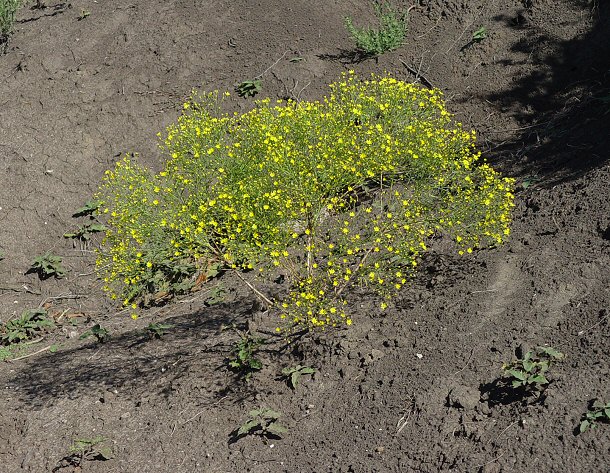Amphiachyris dracunculoides (DC.) Nutt.
Broom Snakeroot

Native
CC = 3
CW = 5
MOC = 27
© DETenaglia
Amphiachyris dracunculoides (DC.) Nutt.Broom Snakeroot | |
 |
Native CC = 3 CW = 5 MOC = 27 |
© DETenaglia |
|
Family - Asteraceae/Astereae Habit - Taprooted annual forb, sometimes with slightly woody base.
Stems - Strongly ascending to erect, to 1 m, solitary, with numerous loosely ascending branches from below the midpoint, usually with faint, longitudinal lines or angles, glabrous. Lower stems sometimes appearing woody.
Leaves - Stem leaves sessile or less commonly short-petiolate, 0.5-6.0 cm long, the blade narrowly linear to linear-lanceolate or linear-oblanceolate, mostly sharply pointed at the tip, more or less tapered to the nonclasping base, the margins entire, the surfaces glabrous but with moderate to dense, impressed, resinous dots, often somewhat sticky to the touch. Basal leaves absent.
Inflorescence - Appearing as flat-topped or irregularly domed panicles, the heads solitary or in small, loose clusters at the branch tips, the branch tips and stalks short to relatively long, with few leaflike, linear bracts 0.3-1.0 cm long, the heads also usually closely subtended by 2 or 3 small, linear bracts.
Heads - Radiate, sticky, resinous. Involucre 2.5-5.0 mm long, narrowly cup-shaped to obconical. Involucral bracts in 2 or 3 unequal, overlapping series, oblong-lanceolate to oblong-ovate, with a straw-colored to yellowish, hard, shiny basal portion and an ascending, triangular, green tip, glabrous but the green portion finely resin-dotted. Receptacle flat or slightly convex, with noticeable toothlike ridges around the attachment points of the florets.
Flowers - Ray florets 7-10, pistillate, the corolla 4-6 mm long, yellow, sometimes persistent at fruiting. Disc florets 10-25, staminate (style branches not separating at flowering; florets not maturing into fruits), the corolla 2.5-3.2 mm long, yellow. Pappus of the ray florets absent or more commonly a minute crown of scalelike teeth. Disk 3 mm broad, with about 15 florets. Pappus of the disc florets of 5-9 minutely toothed awns or slender scales, these about as long as the corolla, fused toward the base, usually white.
Fruits - Achenes 1.5-2.2 mm long, oblong-obovoid, sometimes slightly flattened, with 7-9 fine, green nerves, the surface otherwise densely pubescent with short, white hairs, purplish brown to nearly black. Flowering - July - October. Habitat - Upland prairies, limestone and dolomite glades, bluff tops, riverbanks, fields, disturbed sites, roadsides, railroads. Origin - Native to the U.S. Other info. - This attractive little species can be found in the southwest corner of Missouri. Beyond Missouri its range extends mostly southward and westward into Kansas, Oklahoma, and Texas, with smaller populations found in a few other Midwestern and Southern states. The plant nearly always grows from a single trunk-like base, branching widely in the upper half (the whole plant often being wider than tall). This character and the numerous small, yellow, radiate heads are good clues for identification. This species grows in profusion along roadsides in parts of the Great Plains and is quite common there. Photographs taken at Tall Grass Prairie National Preserve, KS., 9-18-06 (DETenaglia); also at Glade Top Trail National Scenic Byway, Ozark County, MO, 9-23-2017 and 8-16-2023 (SRTurner). |